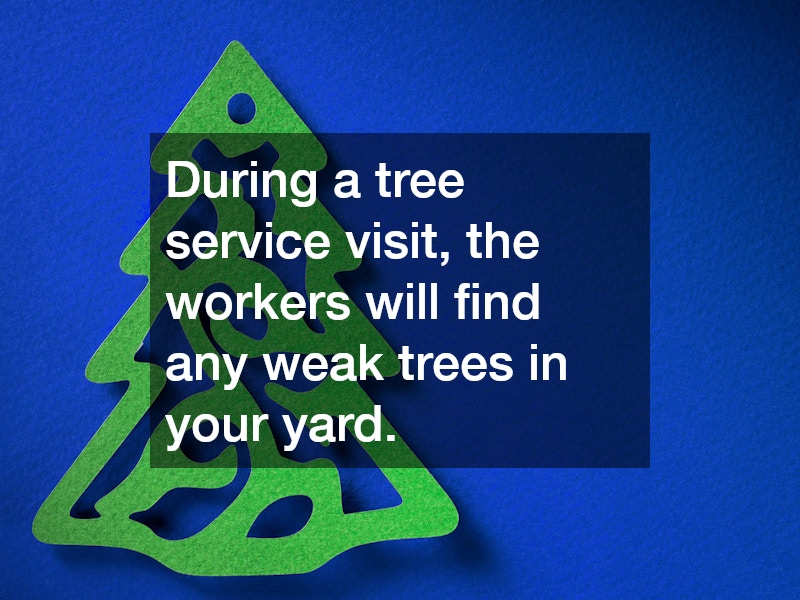
When you’re a homeowner, there are many things that will prepare your home and property before winter arrives. Before winter changes the soil in your yard, you need to contact one of the professional tree cutting services in your neighborhood to inspect your trees. When a tree service arrives, they will determine which trees must be trimmed or removed, and what soil treatments you may need.
During a tree service visit, the workers will find any weak trees in your yard. According to Arborist Now, one of the most visible indications of tree weakness is a hole in the tree’s trunk. A tree service is also likely to hack off branches that are dangling, or remove branches with peeling bark.
After removing weak tree parts, the staff may also perform routine pruning services.If the tree has a lot of high branches, they may perform a technique called “crown reduction.” This service can help the tree resume a healthier growth pattern, as it will then distribute its branch growth to a more typical branch pattern. According to the Old Farmers’ Almanac, if you contact the tree service during the pruning season, they are more likely to offer routine pruning services.
Even though fall is busy for most people, it is an ideal time to prep your home for winter. As the cold season approaches, many parts of your house will need your attention. From deep-cleaning your kitchen cabinets to tuning-up your HVAC, there are tasks you shouldn’t ignore.
This article will provide an outline for the chores you need to have on your fall preparation checklist.

Heating and Air Conditioning Systems
As you prep your home for winter, make sure your HVAC system is at optimal efficiency. Something as simple as dust can considerably reduce the efficiency of your furnace and AC. Grime can add a layer of insulation on electronic parts, which limits its capacity.
During the summer and fall, your home is busy with activities. Your HVAC usually runs more, and as a result, collects a lot of dust and debris. A filter change can considerably boost the efficiency of your heating system.
Besides dust, your AC is susceptible to other technical issues that could affect its output in the winter. Autumn is thus the best time to address heating inefficiencies with your furnace.
You can prep your home for winter by looking for signs of technical problems with your AC. Check if there are signs of water pooling around the compressor. Moisture could be an indication of drain-pan blockages. It may also indicate that your equipment is not adequately conditioning your interior space.
Insufficient or irregular heating is another problem you need to address before the cold season starts. If your equipment keeps starting and stopping, there are likely blockages in the ducts. However, it could also be a result of other issues.
You can solve some of the issues with your HVAC, such as cleaning or replacing the filter. However, consider consulting a certified professional for any technical problems. It is better to invest in a professional service now and avoid problems cropping up during the cold season.
A HVAC expert can troubleshoot hard-to-reach components. Your system may need a furnace replacement. Again, cleaning is also necessary to remove layers of dust on parts such as the evaporator coil. Additionally, a professional can provide insights that can help your enhance your equipment’s efficiency.

Conduct an Energy Audit
If there is an issue with temperature regulation in your home, the source could be outside of your AC system. Your home insulation and the quality of the HVAC installation can impact the efficiency of the system.
As you prep your home for winter, schedule an energy audit from a reputable AC service. An audit can unearth problems with your HVAC installation. Your ducts may have blockages, and in extreme situations, rodents and pests.
Note that cracking is commonplace on windows and doors. As they age, the frame around windows can create gaps that allow warm air to escape. A new installation is one way to increase the energy efficiency of your home.
However, a more cost-effective option is to check the weather-stripping on movable parts of the frame. Caulk is suitable for the fixed sections of the window. Use an appropriate sealant to ensure air does not seep out of the room.
An energy audit can pinpoint the areas of your home that need insulation. Your attic, living room window, or garage doors might have small defects that cause energy losses. You, therefore, need widow and garage door repairs even as you prep your home for winter.
A professional has the skill to determine the most appropriate insulation for your region and climate. They can suggest simple changes that can improve your home’s energy efficiency. For example, keeping all the doors and windows tightly shut can reduce your heating needs.

Check Your Roof
Roofing is another part of your home; you cannot afford to ignore it as you prep your home for winter. When the cold season arrives, your roof should be in perfect condition. Pools of water can compound leakage problems and increase the expenditure for residential roof repairs later on. The average cost of acquiring a new roof is between $5000 to $10,000, which is a significant investment for many homeowners.
You can always examine your roof from the ground with a pair of binoculars. Look for signs of missing or damaged shingles. Remember that the shingles should not be bending or blistering.
Examine the flashing and check for indications of cracking caulk. If you can spot moss on the roof, it is often a symptom of moisture problems. Mold can get to parts of your roof and damage the underlying structure.
Ensure that you remove twigs and branches from the yard. When there are storms, the wind can throw those objects against your siding and roof. The force of the debris may break shingles or cause other costly damages.
It is also wise to set aside time to remove debris from the gutter. Twigs and branches can block the drainage of water away from the roof. As water accumulates, it will eventually lead to structural problems and leaks.
You can avoid unnecessary roof repairs by ensuring the downspouts are not sagging. The assembly should drain water at least 10 feet away from the foundation. Check whether the downspouts are draining properly. Make a point of creating a schedule so that the gutters on your house are clear before the cold season starts.

Clean the Chimney and Fireplace
As you prep your home for winter, you can focus on your HVAC and forget your fireplace and chimney. Those areas of your house accumulate a lot of smoke and soot through the seasons. You can prevent hazards by ensuring you organize an inspection before the cold season starts.
One of the things you need to watch out for are cracks around the chimney and flue. Cracking allows moisture and gases to get into your chimney. Over time, those elements can deteriorate the tiles.
Do not forget to check for bird nests. Any accumulated debris can limit the stream of smoke out of the chimney. These then increases the risk of carbon monoxide poisoning.
The most dangerous byproduct of combustion that can accumulate on your chimney is creosote. The substance is toxic and is responsible for many residential fires. It can cause flue tiles around the chimney to breakdown, which leaves your home susceptible to all kinds of problems.
You can also reduce the risk of a fire by putting away any flammable materials around fireplaces. Gasoline and cooking oil containers can quickly catch fire. A roofing professional should inspect the chimney annually to remove creosote and keep your home safe.
Prevent Water and Flooding Problems
Water damage can ruin parts of your property. Flooding can adversely impact walls due to uneven pressure distribution on either side. Your foundation can also weaken when there are pools of water building up around it.
During the cold season, frost can further weaken the concrete wall. That is why preventing water damage should be a top priority as you prep your home for winter. It is the best time to organize a pool maintenance service.
You need to fix cracks on concrete structures to minimize damage from temperature fluctuations. You can walk around your driveway and examine the walls for signs of wear and tear.
You can also prevent water damage by leveling out any low points around the foundation. When water accumulates along the edge of the building, the soil underneath may begin to shift. For that reason, you must eliminate the potential sources of flooding.
Faulty plumbing is also another possible source of flooding around your home. As water freezes, it expands within the pipes. Eventually, cracks form and may cause leakages around your property. Therefore, you should drain your piping as you prep your home for winter.
A plumbing and septic tank service can inspect your home as you get ready for the coming season. A professional can check the sewer drain using advanced video tools. With the latest equipment, a plumber can accurately detect leaks before they cause a costly flooding problem.
Check Your Home’s Safety Systems
During the cold seasons, we tend to confine most of our activities indoors. Residential fires are frequent during that period. Fire is the most expensive of homeowners insurance claims, even though it ranks fourth in frequency, behind wind and flooding.
You can reduce the risk of fire by preparing your home safety systems for the cold weather. Statistics also show that most incidences happen around the cooking areas. Therefore, it is wise to install smoke and carbon detectors in places where there is any combustion.
As you prep your home for winter, ensure that all the detectors are working. Check the batteries in the device and replace them. Don’t forget that carbon monoxide is colorless and odorless. That means that when there is a leak, detectors are the only way you can determine if there is a CO hazard.
Prepare Your Lawn
You have approximately two months before the cold season to prepare your lawn. Fall is the best time to work on the turf so that it is green and healthy before winter. For optimal results, you should start the process between October and November.
Rake the leaves from your lawn, and do not allow them to pile up. Decaying organic matter is a magnet for pests and rodents. They also block sunlight from reaching the lower parts of the stems. A pile of leaves will leave unsightly yellow spots on your grass.
Keeping the roots healthy is essential before winter. That way, when spring arrives, your lawn will be ready to sprout back to life. One way to keep them healthy is by aerating the soil to allow room for breathing. You can aerate by poking the ground with a garden fork.
You can always mulch plants in your yard during the fall. Mulching prevents moisture from escaping and, therefore, keeps the shrubs and flowers healthy. It also helps in maintaining the quality of the soil.
However, be careful not to suffocate the plants in your yard when mulching. The best method is to apply leaves or bark dust with a specially designed mower. Application methods can vary, depending on whether your goal is to suppress weeds or enrich the soil.
Keep the grass short so that the longer stems do not block sunlight. However, try to keep the trim above two and a half inches to three inches. If you cut the grass too short, you may end up weakening the roots. As winter approaches, the plant will struggle to survive through the harsh weather.
Deep Cleaning Your Home
Autumn is an ideal season to do a thorough cleaning of your home. As activities slow down from summer, you have the chance to organize your household items. Consider eliminating clutter from your home by getting rid of your unused personal belongings or creating proper storage.
After the warm weather, your kitchen will need some deep cleaning. By removing the grime, you can keep mice and termites at bay. If you’ve noticed a pest infestation, remember to call rodent removal services before winter begins.
Vacuuming your carpet is hardly enough to remove dirt and allergens. You can invest in a steam cleaner, or you may hire a service to do the task. The steam can get to deeper layers of your furnishing to remove odor and stains.
Clean out the lint inside in and around your dryer. If lint accumulates, it can increase the risk of fires. Be sure to check behind the dryer and for signs of buildup. Also, disconnect the appliances outlet pipe and wipe thoroughly.
Another tip to help you prep your home for winter is to keep your windows clean using appropriate cleaning agents. When the window has dirt on its pane, it blocks light from getting into the house. Take the opportunity to dust your curtains, couches, and fixtures including, outdoor lighting.
Most of the tasks will require you to invest either time or money. However, the activities are worth the investment. They will ensure your home is ready for winter, and you are less likely to face any major eventualities.
Like this: house ready, before weather, cold weather house tips, furnace check up before winter, getting home ready for winter, getting your home ready for winter, home prep for winter, home winterization supplies, house of preparation, how to insulate home for winter, how to prepare for freezing weather, how to prepare for the snow, how to weatherproof home for winter, how to winter, how to winterize your home checklist, my house is cold in the winter, preparing for winter safety, see system, snowstorm preparedness, tips for the cold weather, weather proofing house for winter.





